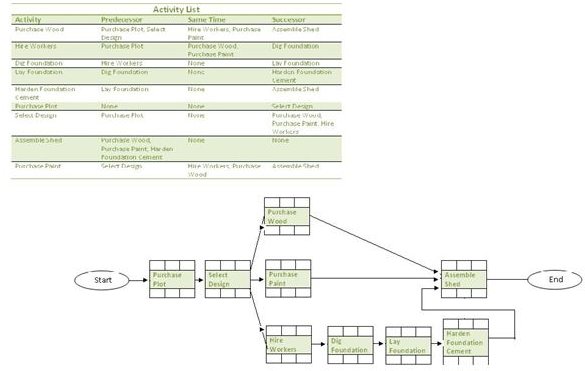Cost Management PMP Quiz – Project Management Certification
Instructions
This quiz contains eight PMP practice questions. You should attempt these questions in 10 minutes by choosing the best option. The answer key is provided at the end of the quiz. The answer key also contains links to further reading material available at Bright Hub.
Your aim should be to get seven or eight questions correct. Good Luck!
PMP Practice Questions
- If the CPI of a project is 1.15 and the SPI is 0.7, which of the following techniques would probably help you bring the SPI closer to 1?
A) Rolling Wave Planning
B) Reserve Analysis
C) Crashing
D) Funding Limit Reconciliation
- Suppose you have a budgeted cost of a project at $900,000. The project is to be completed in 9 months. After a month, you have completed 10% of the project at a total expense of $100,000. The planned completion should have been 15%. At the current progress rate, how much more money is required to complete the project?
A) $ 800,000
B) $ 900,000
C) $ 1,000,000
D) $ 1,100,000
- For you project, you have hired a freelancer to develop a website in .NET. After a month, you decide that the freelancer isn’t doing a good job and reach out to another freelancer. The second freelancer convinces you that your website project would be better off based on the Java platform. The costs associated with the .NET developer are:
A) Variable
B) Direct
C) Indirect
D) Sunk
- If you use the Funding Limit Reconciliation technique while performing the Determine Budget process, which of the following will NOT change?
A) Activity Cost Estimates
B) Schedule
C) Resources required during an Iteration
D) Planned scope to be delivered in a Sprint
- Suppose you are managing a software development project. The project is expected to be completed in 8 months at a cost of $10000 per month. After 2 months, you realize that the project is 30% completed at a cost of $40,000. What is the Earned Value (EV) and the Cost Variance (CV)?
A) EV = $24,000; CV= ($16,000)
B) EV = ($20,000); CV= $16,000
C) EV = $16,000; CV= ($4,000)
D) EV = ($16,000) ; CV= $4,000
- To protect your project from cost overruns, which of the following can you do in the planning phase of the project?
A) Pad high risk activities with extra cost buffer
B) Provide extra time for each activity in the schedule
C) Monitor each activity closely
D) Apply Earned Value Forecasting Formulae, such EAC and ETC
- When a product is recalled, the ____ increases.
A) Activity Cost
B) Cost of Quality
C) Product Quality
D) Product Maintenance Cost
- View the Precedence Diagram below.
One of the activities in the project is to procure wood. You, however, have decided to use Wood Plastic Composites (WPC) because they are more environmentally friendly, more durable, and require less maintenance compared to solid treated wood. As you want the shed to last many years, low maintenance is a key factor while choosing the material. This is an example of using _________ to make an informed decision.
A) Cost of Quality
B) Direct Costs
C) Costing associated with Leads and Lags
D) Life-Cycle Costing
Answer Key
Mentioned below is the answer key to the PMP practice quiz and some PMP resource links that’ll help you improve your project management knowledge.

-
Since the CPI is over one and SPI is less than one, it means that the project is currently not over budget, but is behind schedule. Rolling Wave planning does not impact the schedule. It is a type of planning used when there isn’t enough clarity to plan for the complete project. Options B and D are techniques used in the Determine Budget process. Option C, Crashing, is used to accelerate project progress at the expense of increased cost and risk. For more information, read the When to Crash or Compress a Schedule article.
-
The question is indirectly asking you to compute the Estimate to Complete (ETC). For the worked out solution, read the <strong>Examples of Project Forecasting Computations</strong> article.
-
Since you have been convinced to go with the Java platform, all of the .NET related code cannot be used. Therefore, this is an example of sunk costs. For more information, read the <strong>Example of Costs in Project Management</strong> article.
-
Funding Limit Reconciliation can lead to changes in schedule and resources required. As schedule is being changed so can the expected scope in an Iteration. Activity Cost Estimates are NOT based on Funding Limits. Therefore, Option A is the only valid answer. Read the <strong>Techniques for Determining a Project Cost Budget</strong> article.
-
For the worked out solution, read the <strong>Examples of Cost Variance (CV) and Schedule Variance (SV) in a Project</strong> article.
-
This question assesses whether you know how to implement Reserve Analysis in a project. Option B does not protect against cost overrun, rather it is a schedule buffer. Option C is not a planning activity. Option D is not a planning activity. Therefore, Option A is the only valid answer. For more information, read <strong>Protect Your Project Against Cost Overruns</strong> article.
-
The question is related to Cost of Quality (CoQ). For more information, read the <strong>Using the Cost of Quality (CoQ)</strong> article.
-
The scenario is related to making a holistic decision regarding material to build shed. The factors maintenance and durability are inputs used during Life-Cycle Costing. For more information, read the <strong>What is Life-Cycle Costing?</strong> article.
Bonus PMP Question
Which of the following is NOT a factor when determining the length of an Iteration?
A) The Release Length
B) The Degree of Uncertainty
C) The Cost of the Project
D) The Student Syndrome
Read the <strong>Iteration Length - Key Factors & Time Boxing</strong> article for the answer.
More Free PMP Quizzes
For more free PMP practice questions, refer to:
